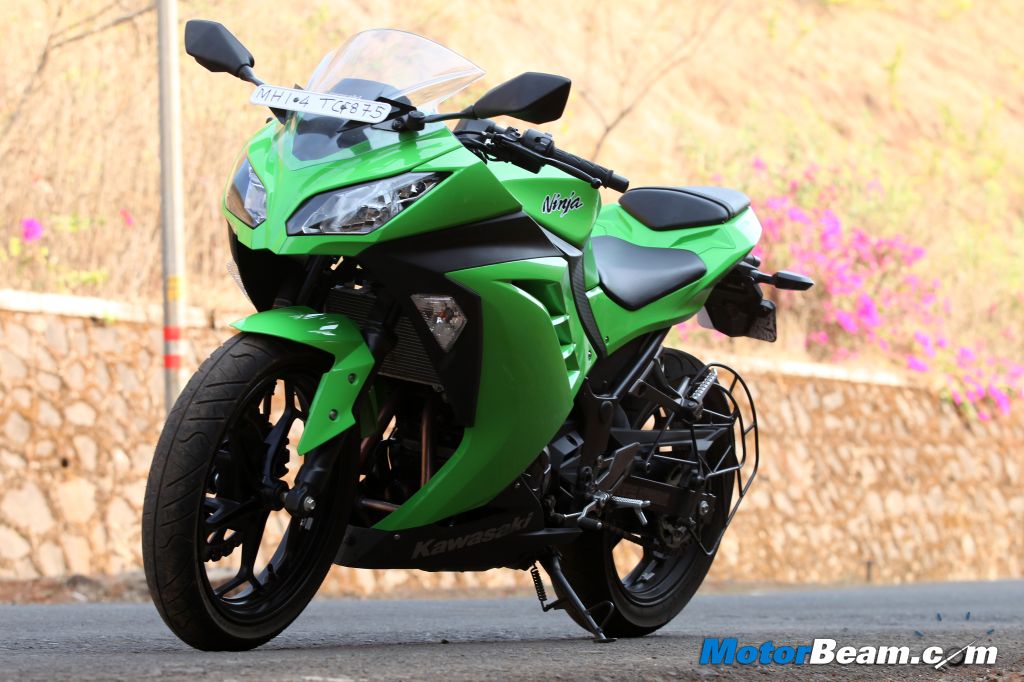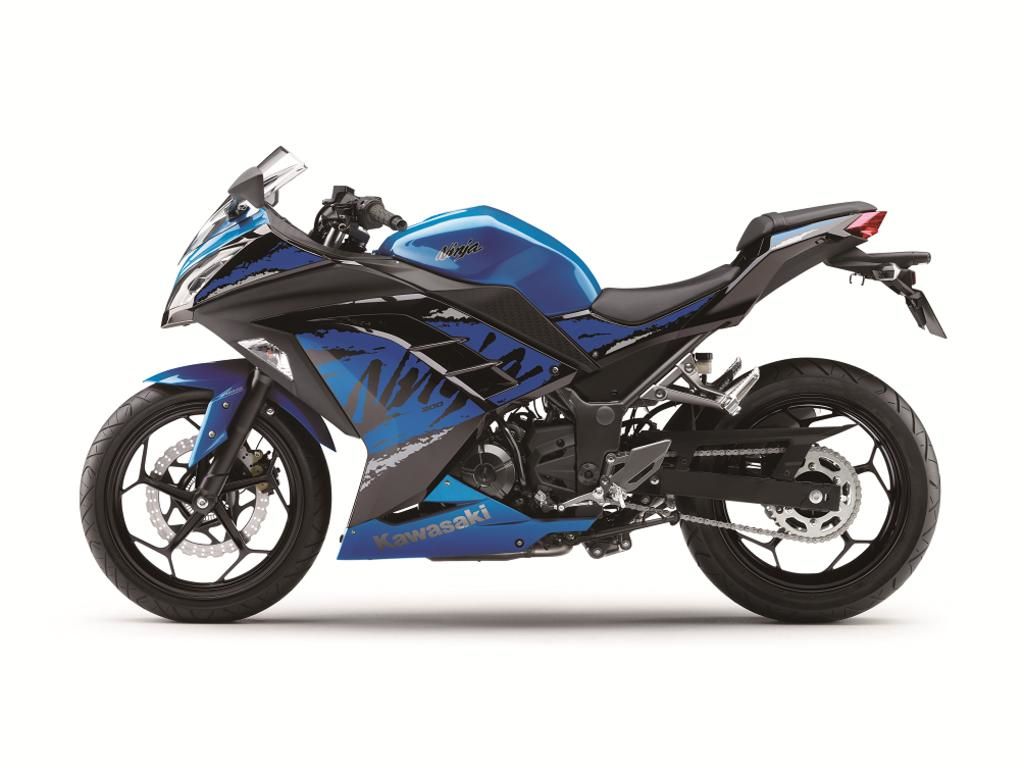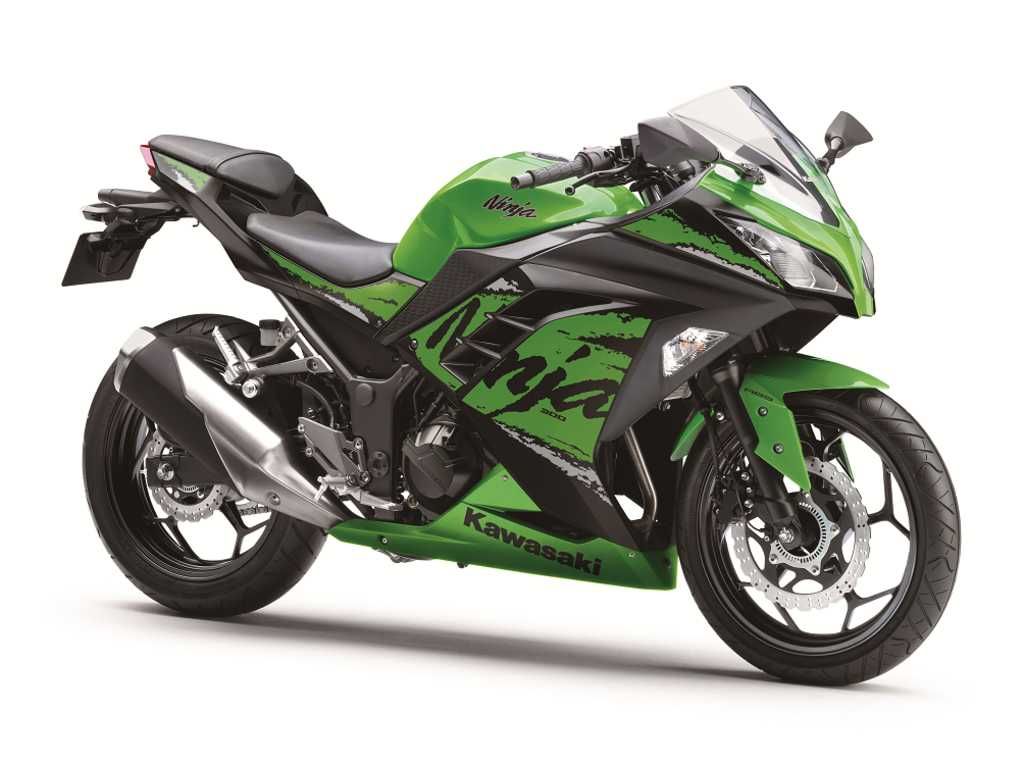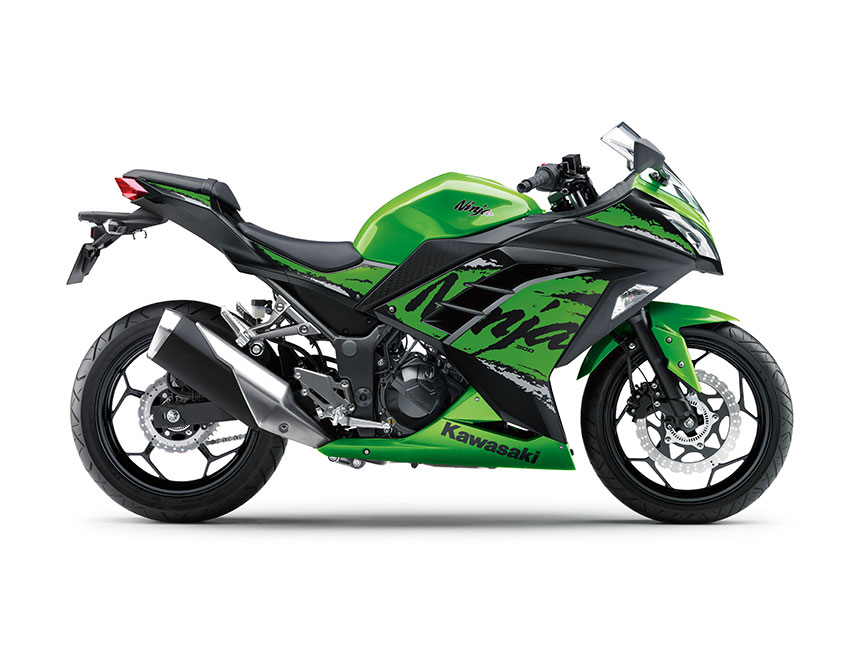
Kawasaki Ninja 300 Review
Bike tested: 2013 Kawasaki Ninja 300
Price OTR Pune: Rs. 3,89,500/-
The Ninja 300 has some serious performance on offer, which gets unleashed once you smack the throttle past 8000 RPM.
Kawasaki is partly responsible for jump-starting the sports bike scenario in the country. When Kawasaki launched the Ninja 250R in India, three years ago, it gave the Indian bike enthusiasts what they exactly wanted – a fully faired, quarter litre motorcycle with wicked performance and eye catchy looks. The Ninja set a benchmark when it came to performance too. Like any other Kawasaki, the bike was packed with innovative technologies and class leading performance. The 33 BHP parallel-twin engine, the screaming performance and the razor sharp dynamics were the forte of the Ninja 250R. However, the Ninja 250R did start to look out-dated with a lack of essential equipment and much required styling updates. Kawasaki has finally updated the 250R by launching the Ninja 300! While some markets continue to get the refreshed 250R, we get the Ninja 300. A good move by Kawasaki once again to keep the ever-craving enthusiasts happy. We get the opportunity to ride and find out how good this Kawasaki Ninja 300 fights!
[flickr size=”center” float=”medium”]http://www.flickr.com/photos/motorbeam/8683573788/[/flickr]
Styling – The Ninja 300 is a sharp, compact and substantial looking motorcycle. Clean lines and edgy panels dominate the design. The Kawasaki Ninja 300 takes design cues from bigger Ninjas. The big muscular fuel tank, the large floating windscreen, the twin angular headlights and the integrated indicators are undoubtedly ZX-10R inspired. The slats in the front fairing are inspired from the 2013 Ninja 1400 GTR. The multi-spoke wheels and exhaust is heavily inspired from the 1400 GTR as well. The rear remains largely unchanged. The exposed sub-frame, the brushed aluminium foot pegs and the texture on the black plastic panels add flare to the motorcycle. Overall, the scaled down design is a welcome change and always grabs attention, increasing desirability by a huge margin.
[flickr size=”center” float=”medium”]http://www.flickr.com/photos/motorbeam/8683572946/[/flickr]
Instrument Cluster and Switch Gear – The twin pod cluster has a logical layout. The large tachometer and small digital speedometer gels with the Ninja 300’s characteristics. The white backlight is an excellent color of choice. Every warning light gets a dedicated indicator. Host of warning lights are included, such as the low battery voltage, engine temperature, OBD port, engine oil pressure and the usual neutral shift light, high beam and the solitary indicators. Two trip-meters, a clock and a three pod sign in digital speedo meter flashes when you drive in economy mode. The switchgear and the palm grip is made up of high quality plastic and the piano black finish on every switch is an excellent touch.
[flickr size=”center” float=”medium”]http://www.flickr.com/photos/motorbeam/8683573464/[/flickr]
Ergonomics – The seating position on the Ninja 300 is comfortable yet sporty at the same time. You do get the big bike feel when you are riding. Thanks to the lower set foot pegs and 790 mm seat height, any average Indian rider’s feet can touch the ground. The seat cushioning is on the harder side for both the rider and the pillion. The tank is sculpted according to the seating position, so you can grip the tank when riding enthusiastically. The rear view mirrors are well positioned and offer a good view of what is behind. Long rides will be comfortable on the Ninja 300.
[flickr size=”center” float=”medium”]http://www.flickr.com/photos/motorbeam/8682458661/[/flickr]
Performance and Gearbox – The Kawasaki Ninja 300 is powered by a twin-cylinder, liquid-cooled, fuel-injected, 296cc, 8-valve motor churning out 39 PS at 11,000 RPM and 27 Nm of torque at 10,000 RPM. This all aluminium engine is derived from the Ninja 250R. The stroke has been lengthened for increasing the cubic capacity. The valves are now bigger, the pistons are lighter and a new exhaust system and a sleeveless cylinder head has been added. The compression ratio has been reduced to take out the maximum performance with the use of normal unleaded petrol.
The fuelling is the most astonishing part of this bike. It manages to give adequate low-end torque to potter around town. The action starts after 6000 RPM and after 8000 RPM it rushes insanely quick to its 13,000 RPM redline. The entire rev band is flawless, no jerkiness and no sudden spikes. Even the redline cut out is smooth and one can hold it as long as needed. The new 32 mm throttle bodies make throttle response precise and linear. NVH levels are excellent. Vibes are well controlled thanks to the rubber mounts for the engine.
[flickr size=”center” float=”medium”]http://www.flickr.com/photos/motorbeam/8683571948/[/flickr]
The engine is mated to a slick shifting 6-speed gearbox assisted by a slipper clutch. The cogs have more teeth to get power from the top end of the rev range (where the power and torque is) but the distance between the cogs is less (short geared). Therefore, once you are in the power band and start shifting aggressively, acceleration off the line is very quick and the bike can reach up to 130-140 km/hr in no time. The clutch is light and progressive. The slipper clutch works precisely and does exactly what it is meant to do, aid confidence when riding hard on a windy twisty road. At any given speed, you can downshift and the wheels will not lock up. Newbie and average riders trying to corner fast will actually end up cornerning a lot faster than they expect.
[flickr size=”center” float=”medium”]http://www.flickr.com/photos/motorbeam/8683572174/[/flickr]
Riding Dynamics – The Ninja 300’s chassis is borrowed from the 250R but there are a host of changes to make it far more dynamically rich. The main tubes have been strengthened using high tensile steel for accompanying the more powerful engine. The chassis length has been shortened by 70 mm for better agility and braking. The wheelbase has gone by 5 mm, adding more stability and aiding in better traction (avoiding power wheelies) while accelerating hard of the line.
[flickr size=”center” float=”medium”]http://www.flickr.com/photos/motorbeam/8682461005/[/flickr]
The chassis has been lowered by 5 mm but the weight has gone up by 3 kgs. The damping of the front and rear suspension has been revised, and it shows. The Ninja 300 handles beautifully. It is agile and remains poised in the corners and holds the line well. The new 140 mm section IRC tyres grip well but an upgrade to superior compound tyres of same dimensions will aid in more confidence. Foot pegs are set lower, a bit higher and getting your knee down would have been a lot easier. The turn is not crisp and enjoyable due to increase in rake degree and trail. Nevertheless, the increase has its own benefits.
[flickr size=”center” float=”medium”]http://www.flickr.com/photos/motorbeam/8683572070/[/flickr]
The Kawasaki Ninja 300 feels more stable and is more communicative while changing directions at high speeds. The able chassis and suspension can handle a bit more oomph easily. The Ninja feels quite nimble when it comes to cutting through traffic. No doubt that the Ninja 300 will do track days but the bike is not a track-focused monster (the reason why the “R” nomenclature has not been adopted for the Ninja 300). The 290 mm petal discs at the front and 220 mm petal disc at the rear with two-pot Nissin callipers on both sides do a good job of slowing down from high speeds. A bit more would have been appreciated (ABS could have helped in this regard).
[flickr size=”center” float=”medium”]http://www.flickr.com/photos/motorbeam/8683573626/[/flickr]
Miscellaneous – An upgrade to sticky soft compound tyres of the same dimensions will aid a lot more confidence. The lamps act as DRL and the right one stays on always. The ground clearance is low, but even with a pillion or missing speed breakers at high speeds saw nothing kissing the ground, thanks to the stiff suspension. Factory rear suspension setting is on the softer side; adjust as per your needs. Head light throw is wide and the illumination is superb. The instrument cluster is not particularly huge but is not small either.
[flickr size=”center” float=”medium”]http://www.flickr.com/photos/motorbeam/8682459841/[/flickr]
There is a storage compartment under the seat and another secret compartment below the first compartment too, neat! As every Kawasaki bike, fit and finish is excellent and paint job is deep. There are no uneven panel gaps and high quality materials are used. Hooks below the rear seat are there to tie extra baggage. There are no grab rails but there is recess right below the pillion seat to hold on too, a cost effective and weight saving trick. Heat dissipation promised by Kawasaki works well, the rider feels that the heat is not directly frying their legs anymore like other liquid-cooled bikes. Kudos to Kawasaki for this comfort feature!
[flickr size=”center” float=”medium”]http://www.flickr.com/photos/motorbeam/8682460419/[/flickr]
Verdict – The Ninja is back and with a loud bang. The ZX series inspired aesthetics, the potent engine, the able chassis and the amazing soundtrack, all combined, make it an excellent performer. The Ninja 300 makes it clear that it is a complete all-rounder. The motorcycle is on top of the chart when it comes to practicality, daily usability and overall comfort which makes it a real strong contender. However, given the high pricing (which has been the case of Kawasaki in the quarter litre segment), the lack of ABS (not even as an option in India) disappoints the enthusiasts. Nevertheless, nothing should stop you from letting the good times roll.
The Kawasaki Ninja 300 is a brilliant package, it is so good in multiple ways, that it simply has no competition to fight.
[flickr size=”center” float=”medium”]http://www.flickr.com/photos/motorbeam/8683571248/[/flickr]
What’s Cool
* Scaled down aesthetics
* Performance and dynamics
* Comfort and practicality
What’s Not So Cool
* Lack of ABS
[flickr size=”center” float=”medium”]http://www.flickr.com/photos/motorbeam/8683572670/[/flickr]
2013 Kawasaki Ninja 300 Specifications
* Engine: 296cc, 8-valve, parallel-twin DOHC
* Power: 39 PS @ 11,000 RPM
* Torque: 27 Nm @ 10,000 RPM
* Transmission: 6-speed manual with slipper clutch
* 0 – 100 km/hr: 6.73 seconds
* Top Speed: 182 km/hr
* Fuel Consumption: 28 km/l
* Fuel Type: Petrol
* Suspension: Telescopic forks (Front), 5-speed Uni-Trak (Rear)
* Tyres: 110/70/17 (Front), 140/70/17 (Rear)
* Brakes: 290 mm petal disc (Front), 220 mm petal disc (Rear)
2013 Kawasaki Ninja 300 Dimensions
* Length x Width x Height: 2015 mm x 715 mm x 1110 mm
* Wheelbase: 1405 mm
* Ground Clearance: 140 mm
* Fuel Tank Capacity: 17-litres
* Kerb weight: 172 kgs
Pictures – Anannd Sampat
Further Reading –
Kawasaki Ninja 300 Video Review
Kawasaki Ninja 300 vs KTM Duke 390
Kawasaki Ninja 300 vs Yamaha R3 vs KTM RC 390
Yamaha R3 vs Kawasaki Ninja 300 vs KTM RC 390 – Video




